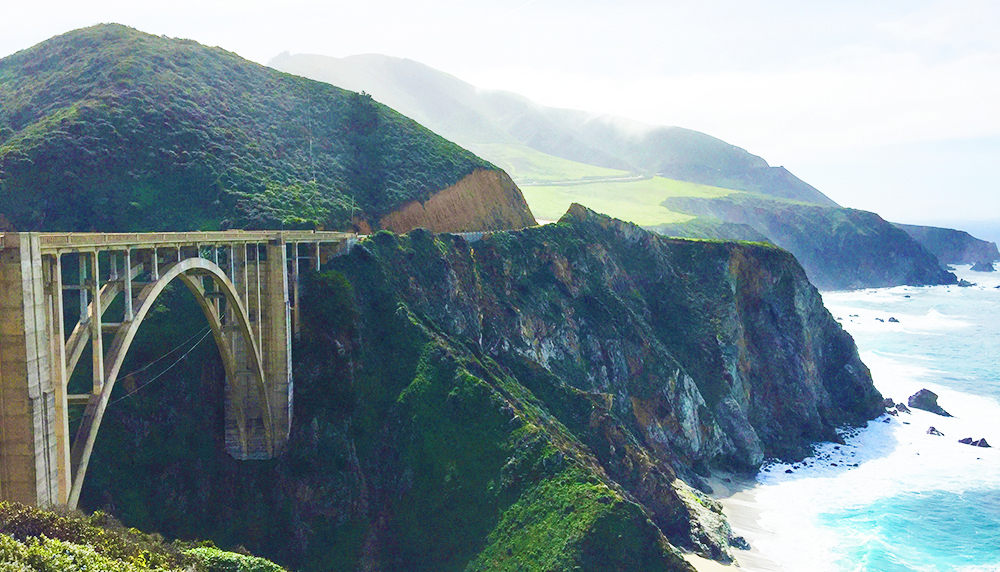
Bridges: Innovative Designs Installed in Unlikely Places
All bridges are not created equal—especially technological ones.
Around here at SSCS, we don’t take bridges for granted. We live near one of the most photographed in the world, Bixby Bridge, along the Big Sur coast line. You know the one we’re talking about:

Bixby Bridge was built in the 1930’s, the same decade as the Golden Gate Bridge, its famous neighbor a few hundred miles up the Pacific Coast. In terms of style, they couldn’t be more different: one is stone; one is metal. One is designed to blend into its surroundings, the other is intended to stand out as a grand engineering statement. Oh, and there’s one more thing: Bixby Bridge does not have a c-store, but the Golden Gate does, as The Warming Hut Park Store is nestled under its span.
The aforementioned bridges are still going strong as they approach 100 years of age, testimony to just how remarkable they are as feats of architecture and engineering. They’re mere youngsters, though, when you consider bridges first started to show up around 4000 B.C., the beginning of a history with lots of high points.
For example, the Arkadiko Bridge in Greece dates from the Mycenaean period around 1300 B.C. It’s the oldest man-made bridge still in partial use. Over a thousand years later, the Roman Empire, builders of roads, also brought bridge construction to another level. A great example of Rome’s civil engineering genius can still be seen in Alcantara Spain. The bridge was completed around 106 A.D. (though it has been redone many times since then). Days can get pretty hot in Alcantara. If they do, you can grab a cool drink from Multitienda El Capricho downtown.
The oldest, fully functioning bridge, can be found in Florence, Italy. It’s called the Ponte Vecchio, and dates back to 1345 A.D. Made of stone, and spanning the Arno River that runs through town, there’s a kind of Medieval jewelry row with stores built right into the same structure. Walk a few blocks down the street and you can enjoy Sapori & Dintorni Conrad, an Italian chain with many familiar c-store items, a gourmet approach to food, and a full commitment to loyalty applications and digital promotions.
Like the Ponte Vecchio, London Bridge started out in 1290 A.D. made of stone, and rapidly became the core commercial district for the city. The Great London Fire of 1666 burned it down, but since then it’s been rebuilt a couple of times, moved to Lake Havasu City, Arizona (!), and rebuilt again, this time from the ground up, resulting in the revitalized, sprawling business development which has grown up around it. The massive Borough Market is not a c-store per se, but you’ll see many reminders of convenience merchandise as you walk through the dozens of specialty stores that come together to form the shopping precinct.
We haven’t forgotten the more modern bridge, say those erected from the last half of the 20th Century until now. In actuality, they are the most impressive of all, being built with materials and technologies that allow for innovative designs installed in places that were not possible before. Here’s three notable ones:
- The Millau Viaduct, France: This stunning cable-stayed bridge spans the Tarn River Valley and reaches a height of 343 meters (1,125 feet)—it’s the tallest bridge in the world. Its elegant design, with graceful curves and slender towers, has earned it a place among the most iconic pieces of modern infrastructure, but it’s in a rural, remote place. Sorry, no c-stores.
- Tsumoshima, Japan: This beautiful bridge features a unique design using traditional Japanese aesthetics blended with modern engineering. It appears to float above the water, a design meant to harmonize with natural landscapes, not unlike Bixby Bridge, but slightly more spectacular. As this is Japan, you can be sure a Lawson isn’t too far away.
- Hangzhou Bay Bridge, China: This bridge is one of the longest ocean-crossing bridges in the world. Its unique “S” shape and towering height make it an engineering marvel. Almost as spectacular are the huge Rt-Marts situated one on each side, with plenty of room to include c-stores, or c-store adjacent businesses.
Bridges aren’t always stone and concrete, but they do always bring two things together, or they wouldn’t be bridges. The concept applies to technology, too, which is how we came up with the name for CDBWin’s G/L Bridge feature. This software allows you to generate a journal entry file, then seamlessly import it into leading third-party general ledger programs. It makes the process simpler and smoother, and keeps your information flow fast and true. Give us a call at (800) 972-7727; we’ll provide the details.






Leave A Comment